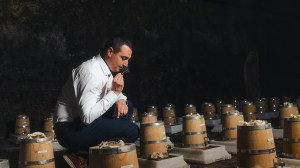In the humid depths of Rémy Martin’s cognac cellars, Baptiste Loiseau hovers over a small wooden vessel called a tonnelet, no bigger than a watermelon. Inside, a perfume has been aging for months.
This space is central to the creation of Maison Psyché, a perfume house inspired by Rémy Martin’s centuries of oak-aging expertise. (In French, the p in “Psyché” isn’t silent, so the pronunciation sounds like “p-see-SHAY”.)
Today, like every Thursday for the past several weeks, Loiseau and perfumer Sophie Labbé will decide whether to let time continue its work on any of the dozens of small oak barrels, and which ones are ready for bottling. The stakes are considerable: each tonnelet represents months of patient waiting, thousands of euros in materials, and an irreversible decision that cannot be replicated.
“At one point, you have the emotion that is arising, and you say, ‘OK, this is now the moment that we will stop the aging,’” Loiseau explains. He became Rémy Martin’s cellar master in 2014 at age 34, making him the youngest person ever appointed to the position. Loiseau’s background as a winemaker brings additional perspective to the timing decisions that define both cognac and, now, aged-perfume production.
Baptiste Loiseau inspecting Maison Psyché’s tonnelets at Rémy Martin’s French headquarters.
Maison Psyché
Loiseau and Labbé’s family histories intertwined before they ever met. “What is very unbelievable is that my father was growing wines for cognac, and Baptiste’s grandfather was growing flowers,” Labbé recalls. “We share this interconnection.”’
Labbé brings decades of expertise in ingredient sourcing and sustainable perfumery practices to Maison Psyché. Her portfolio includes scents made for Calvin Klein, Givenchy, Elie Saab, and Bvlgari.
But at the start of the project, which launched in 2022, their vocabularies differed dramatically. What Labbé calls gourmand, Loiseau calls ‘patisserie’. “We discovered that we didn’t have the same language at the beginning,” Labbé explains. “And it was super interesting to cross-fertilize our potential words, and to add more to both of our universes.”
One word Labbé now deploys more often is “sexy.” Meanwhile, Loiseau now uses floral terminology to describe his cognac’s eaux-de-vie (that is, the distilled grape spirits that form the foundation of each batch). He says this linguistic evolution has enhanced his professional palate.
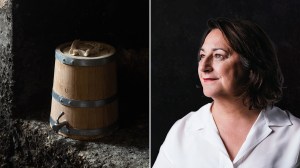
Sophie Labbé, the perfumer behind Maison Psyché’s six alluring fragrances.
Maison Psyché
The pandemic provided an unexpected laboratory for experimentation. With unlimited time and no market pressure, Labbé and Loiseau began aging individual ingredients in these reclaimed cognac barrels, expecting failure more often than success.
“We were thinking, it’s not going to work,” Labbé says of early trials with citrus oils. “Can you imagine a fresh, fizzy, very acidic note going to a barrel, or aging in a barrel with the transfer of the wood of the vanilla, the praline notes? And yet, it actually turned out to be fantastic.”
The process was methodical: select sustainably sourced natural ingredients, place them in tonnelets, then conduct weekly smell comparisons between aged and fresh samples over months (and then years) of observation. Each evaluation brought new surprises as volatile citrus notes gained longevity and complexity. The aging process wasn’t just changing the perfumes, it was inverting the fundamental structure of how fragrances evolve on skin.
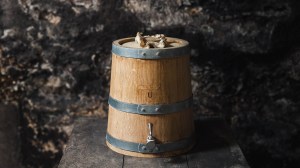
A tonnelet made from ex-Cognac barrels is used to age Maison Psyché’s fragrances.
Maison Psyché
In a market obsessed with instant gratification, Maison Psyché sells patience and calculated risk. Each fragrance represents those months of waiting, and the acceptance that some experiments will fail. The process can’t be rushed, replicated exactly, or scaled infinitely.
“The idea is that we are not controlling the effect of time and the effect of wood, similar to cognac aging,” Loiseau explains. “We can be precise with what we want at the very beginning, but how it will evolve depends on the condition in the cellar, and on the weather. We let time and the atmospheric conditions play their role.”
The current rhythm produces just 200 numbered bottles per batch of the core collection, with some special editions limited to far fewer bottles. The new Éclat d’Ombre will only get 30 bottles.
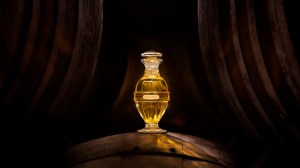
Eclat d’Ombre, Maison Psyché’s sixth fragrance, is based on a chypre accord.
Maison Psyché
Maison Psyché’s philosophy centers on celebrating single hero ingredients, allowing each fragrance to showcase one star component’s transformation through aging.
The proof of metamorphosis lies in direct comparison between the aged versions and “fresh” formulas, which don’t spend time in the tonnelets. Alexanor, Maison Psyché’s bergamot cologne, demonstrates the transformation most clearly. The aged version evolves bergamot into a scent that is “candied, with praline undertones that extend the traditionally ephemeral top notes for hours,” Labbé says. “Usually, the citrus notes are the top notes, suddenly the top notes are becoming the base notes, in a way. It’s an inversion of the pyramid you usually see in perfumery.”
Catherine Sardin, CEO of Maison Psyché, calls the transformation a “rounding effect” on each hero note. “The result is, by design, not as sparkling as the original, but much longer-lasting as a result of the roundness,” she explains.
The Maison Psyché Fragrances
The house launched in 2023 with five scents, each exploring how aging transforms a different category of classic perfumery ingredients. This year, a sixth creation joined the collection—the complex Éclat d’Ombre, which abandons the single-ingredient approach for an atmospheric chypre accord (one that captures the essence of the aging cellars themselves).
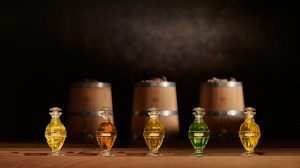
Maison Psyché has a total of six fragrances, each of which has fewer than 200 bottles available.
Maison Psyché
Alexanor (Bergamot): A cologne that defies citrus conventions, transforming bright bergamot into candied, long-lasting warmth with unexpected praline undertones.
Alcyone (Jasmine): Indian jasmine picked at dawn evolves into something “much creamier, taller and exotic,” says Labbé. Thus it gains lactonic, solar qualities.
Belle Dame (Rose): Centifolia roses from Grasse reveal their full spectrum, from crispy bud freshness to generous bloom, capturing what Labbé calls “a kind of rose in all the states.”
Nymphalis (Patchouli): Sharp earthiness becomes “elegant, softer, less earthy” she says. Yet it retains its grounding power, offering an approachable take on patchouli’s notorious intensity.
Hamadryas (Vanilla): Madagascar vanilla gains sophistication through wood aging, balanced with iris to prevent sweetness from overwhelming the composition’s elegance.
Éclat d’Ombre (Chypre Accord): The most atmospheric creation, combining bergamot, rose, and patchouli; the result represents what Loiseau calls “the paradox between light and the shadow that we have in the cellar.”
The attention to craft extends to every detail, from the tonnelet-inspired bottle shape to the numbered plaques that trace each fragrance back to its specific cask origin. The fragrances are housed in crystal bottles that feel substantial in hand, each one unique due to the artisanal glass-making process. Those arrive in lacquered wooden boxes, which echo the cooperage (or barrel-making) tradition and ensure that no two boxes look alike.
In July, Maison Psyché will launch a lacquered case holding travel-sized versions of the first five fragrances, allowing customers to own these scents at a more accessible entry point.
How Cognac Barrels Become Perfume Tonnelets
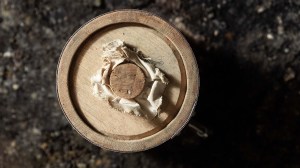
Tonnelets, like Cognac barrels, are sealed with corks.
Maison Psyché
The tonnelet is an invented object—neither a traditional perfume vessel nor a miniature cognac barrel, but something entirely new. Its small size demands the most experienced hands. Behind every tonnelet stands a legacy barrel maker, the master cooper Vincent Nicolleau. He has spent 27 years at Seguin Moreau, the renowned cooperage that has supplied France’s finest wine and spirits houses with barrels since 1838—including Rémy Cointreau down the road, of course. Seguin Moreau is Maison Psyché’s only provider of these tonnelets.
Loiseau and his team first select the cognac barrels to be recycled and downscaled into Maison Psyché tonnelets. Seguin Moreau receives them immediately after emptying, and then quickly “machines the staves” (separating and cutting each wooden segment of the barrel) as quickly as possible to preserve the aromatic signature. “The staves that make up the tonnelet are identical in terms of width, height, and thickness, whereas barrels have varying widths,” explains Nicolleau, who uses 14 staves to make one tonnelet (down from 30-33 for the average cognac barrels, which are assembled more like a puzzle until everything “fits”).
“Most of the casks that we have emptied and used to make the tonnelet are more than 40 years old,” Loiseau notes. “So for us, it was really crucial to have casks that contain a different kind of eaux-de-vie in each.”
The wood selection process proved critical. For example, heavily toasted staves, excellent for cognac, proved disastrous for fragrance, as they would overpower the hero ingredients, Loiseau says.
How to Experience Maison Psyché’s Fragrances
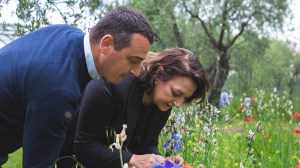
Loiseau and Labbé are descended from flower and grape farmers, giving them a natural link in creating perfume from Cognac barrels.
Timothé Renaud/Maison Psyché
These scents are not available through traditional retail channels. This appointment-only approach allows collectors to understand the specific tonnelet history and aging characteristics of their chosen bottle.
If you’re interested, you have to contact Maison Psyché directly for purchase consultations in Paris at Place Vendôme, as well as in Cognac at Maison Historique Rémy Martin. Arrangements can also be made with advisors around the world through the maison’s Contact page.
Authors
-

Adam Hurly
Adam is a South Dakota native living in Lisbon (and previously San Francisco, New York, and Berlin). Adam writes about grooming and travel for numerous publications, and in 2024 launched Blue Print…

